Texas Railroad History - Tower 212, Lockney and Tower 213, East of Plainview
Two Automatic Interlockers on the
Floydada District of the Panhandle & Santa Fe Railway
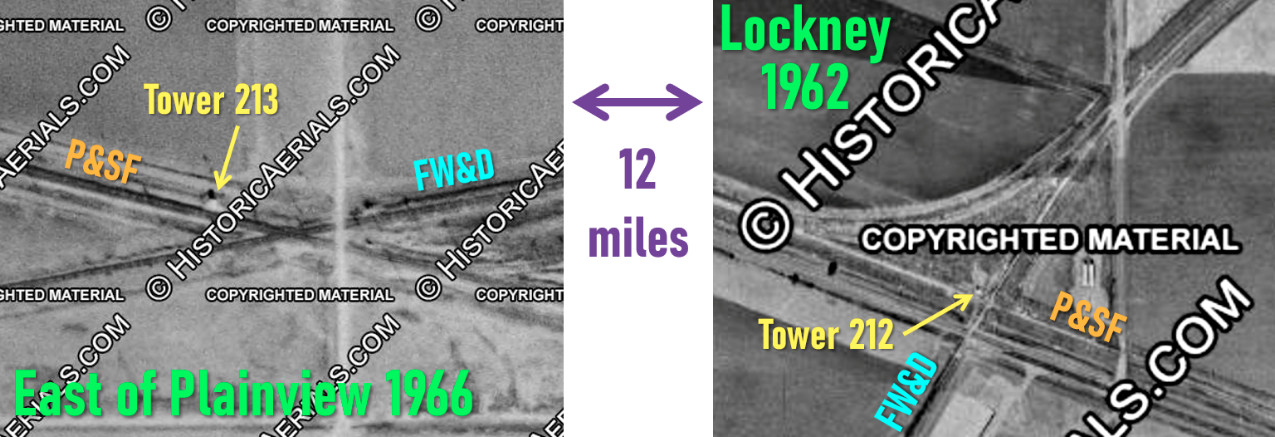
Above: Visible mostly as white
dots topped by black dots, the automatic interlocker cabins at Towers 212 and
213 cast shadows to the north in these aerial images ((c)historicaerials.com)
recorded in 1966 and 1962, respectively. The crossings were a dozen miles apart
in the South Plains of the southern Panhandle of Texas located along the
Floydada District of the Panhandle &
Santa Fe (P&SF) Railway. In both cases, the crossing railroad was the Fort
Worth & Denver City (FW&DC, but usually just FW&D -- "City" was
formally dropped in 1951). Although the crossings were created when the FW&D
built through the area in 1928, they were gated until automatic
interlockers were installed at both sites in 1961.
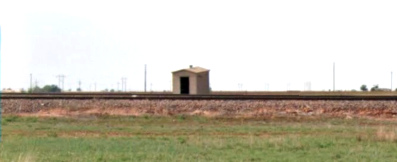 |
Left:
The cabin that housed Tower 213 on the east side of Plainview remains
standing near the crossing, abandoned for many years, at least since
1991. Tower 213 has long been misidentified as being located in
Floydada, but the P&SF tracks did not cross the Quanah, Acme & Pacific
(QA&P) tracks at Floydada and no employee timetables were ever found
that cited an interlocker in Floydada. Tower 213's correct location east
of Plainview was identified when it was determined that two automatic
interlockers were installed on the Floydada District by the P&SF in
1961, but that only one of them, Lockney, had been numbered by the
Railroad Commission of Texas (RCT). More likely, they were both numbered
by RCT at the same time, and the interlocker at the crossing east of
Plainview had been assigned Tower 213. That it was
on
the Floydada District and specifically identified as such in Santa Fe timetables
may have
led to it being mistakenly transcribed as located
in Floydada when the list of numbered interlockers
was researched and compiled in the 1986 - 87 timeframe. (Google Street View, May, 2023) |
In 1928, when the Fort Worth & Denver (FW&D)
Railroad built into the South Plains region south
of Canyon, its tracks crossed the Panhandle & Santa
Fe (P&SF) Railway four times: at Lockney, at Kitalou near
Lubbock, and twice at Plainview. Two of these crossings -- at Lockney and on the east
edge of Plainview
-- were across the P&SF Floydada District. The other Plainview interlocker,
Tower 142, was close to downtown where the FW&D crossed the P&SF main line to Lubbock.
The parent company Atchison, Topeka & Santa Fe ("Santa Fe") Railway created
the P&SF
in 1914 from two subsidiaries: the Southern Kansas Railway (SKR) and
the Panhandle & Northern Texas (P&NT) Railway. The SKR was renamed to become the
P&SF, and the P&NT was then leased to the P&SF. All of Santa Fe's
operations in the Texas Panhandle and the South Plains came under the P&SF banner,
although the title to much of the trackage was still legally held by the P&NT
(which would be dissolved and merged into the P&SF in 1948.) The SKR dated back to 1886,
chartered by Santa Fe to build into Texas from Kansas and Oklahoma. Santa Fe purchased the P&NT in 1901 from its founder, James J. Hagerman.
The P&NT
was first envisioned by Hagerman in 1896 when he decided to build from Roswell,
NM to either Amarillo or Washburn to make a
connection with Santa Fe. Santa Fe agreed to the arrangement and Hagerman
proceeded to obtain a Texas railroad charter in 1898 for the P&NT to own the
Texas portion of his route, as required by state law. The P&NT main line opened
between Farwell (on the New Mexico border) and
Amarillo in 1899. Santa Fe then bought all of Hagerman's Texas and New Mexico
rail interests in 1901. A few years later, Santa Fe elected to use the P&NT
charter for track expansion into the South Plains.
For both short
term and long term reasons, Santa Fe needed a route from the P&NT main line
deeper into the South Plains region toward Lubbock. Cattle ranching was the
primary commerce, but commercial production of wheat and cotton was increasing.
For many miles, Plainview and Lubbock were the only towns of any size south of
Canyon, but both were very small and neither had rail service. Plainview
had been founded c.1886 through the efforts of two settlers, Z. T. Maxwell and
Edwin Lowe, who had simply decided to establish a town near their land. Having
secured a post office in March, 1887, Plainview became the county seat when Hale
County was organized in 1888. Lubbock was another 42 miles farther
south, the county seat of Lubbock County. It had been founded by land promoters
in 1891, although a Lubbock Post Office had been granted for a tiny outpost in
the county in 1884.
As Santa Fe began building south from Canyon
in 1906, the citizens
of Floydada, 75 miles southeast of Canyon, were already looking to build a railroad to their town from
the nearest Santa Fe branch point. Their initial goal may have been Canyon; a
direct route to Canyon would pass through Lockney, eleven miles northwest of
Floydada, so it may have been easy to get Lockney investors involved. Lockney
had been founded in 1889 by citizens from the community of Della Plain searching
for a better source of water. The rail connecting point became Plainview by the time
construction began as Santa Fe had completed their Canyon - Plainview line in
January, 1907. The most direct line between Floydada and Plainview would have passed
four miles southwest of Lockney, but the routing through Lockney was retained.
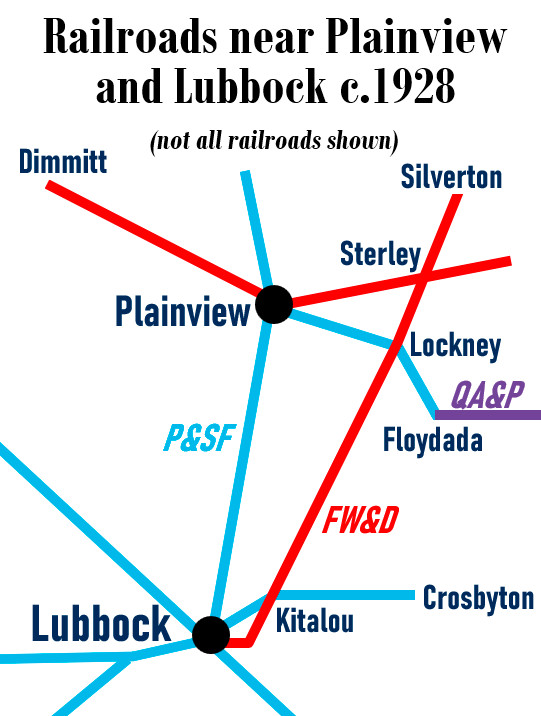 |
Left:
rail lines in the vicinity of Lockney and Plainview c.1928
Construction began at Plainview and moved east. The Floydada
investors sold out and Santa Fe took over the project in early
1910. The Lockney Beacon (quoted in
the Thursday, February 17, 1910 edition of the
Crosbyton Review) reported the
track-laying machine entered Lockney "...Tuesday evening at about
6:30 o'clock...almost the whole of the population of the city were
present to witness the important event." This sets February 15,
1910 as the date for track-laying in Lockney, a task undoubtedly handled
by Santa Fe. The Snyder Light quoted
by the Abilene Daily Reporter of March
29, 1910 announced "...Santa Fe has inaugurated train service on the
new branch line from Plainview to Floydada." Officially, Santa Fe
did the construction under the charter of its P&NT subsidiary as the
P&SF would not exist for another four years.
By the time
Santa Fe took over the Floydada construction, it had already completed
its line from Plainview to Lubbock. Over several years, it would add
branch lines in the Lubbock area to Slaton, Crosbyton, Bledsoe, Seagraves and Lamesa.
The Slaton branch became part of a lengthy main line from Farwell
through
Lubbock to connect farther southeast with another Santa Fe subsidiary, the
Galveston-based Gulf, Colorado & Santa Fe
(GC&SF) Railway. The GC&SF's progress to the northwest had stopped at
Coleman in 1885. The tracks between Slaton and Coleman opened in May,
1911, and the extension from Lubbock to Farwell opened in March, 1914.
The
South Plains track network remained generally static until 1928 when the
FW&D began construction into the area. The
work was done under a new charter, the Fort Worth & Denver South Plains
(FW&DSP) Railroad, owned and operated by the FW&D. The FW&DSP
built two lines. One began at Plains Junction near Estelline, a town on the FW&D main
line several miles northwest of Childress. It went west to reach Plainview and terminated at
Dimmitt farther northwest. The other line ran between Silverton and Lubbock;
its only connection to other FW&D tracks was at Sterley, a community
that arose at the crossing of the Estelline - Dimmitt line.
Also
in 1928, the QA&P finished their line into Floydada from
Quanah and connected with the P&SF. The
QA&P quickly initiated traffic exchange, a development that Santa Fe did
not want because it preferred a different
interchange with the QA&P's parent railroad, the St. Louis & San
Francisco ("Frisco") Railway. This would become a source of
conflict between Santa Fe and the QA&P / Frisco for a decade.
|
Trains on the FW&D main
line out of Fort Worth could proceed northwest to Estelline, turn west to
Sterley and then turn south to Lubbock. This provided the first efficient
"single railroad" passenger service between Fort Worth and Lubbock. As
the only rails out of Lubbock had been Santa Fe's, passengers to Fort Worth had
to change railroads (and
depots) at either Amarillo (FW&D) or Sweetwater (Texas & Pacific),
or perhaps travel beyond Sweetwater all the way to
Temple to catch a GC&SF train to Fort Worth. The FW&D's
new construction benefitted commerce between north Texas and the
South Plains, but it put Santa Fe management in a dour mood. The South Plains
had been Santa Fe's exclusive territory for twenty years.
The 1928 FW&DSP
construction at both Lubbock and Plainview created the need for the interlockers
commissioned as Towers 141 and 142, respectively. The FW&DSP also crossed the
P&SF at Lockney and at a site on the outskirts of Plainview two miles east of Tower 142.
There was
limited traffic on the Floydada District, hence no need to interlock either
crossing, but both were gated, allowing restricted speed approaches.
Although the QA&P tracks into Floydada connected to the P&SF, there was no
actual crossing and no need for an interlocker.
Less than a year
after inaugurating service from Fort Worth to Lubbock, the crash of the New York
Stock Exchange in October, 1929 foretold the coming of the Great Depression. By
1931, the FW&D's daily passenger train serving Lubbock and Plainview from Fort Worth could no
longer be justified. It was scaled back, becoming daytime service from
Childress and in later years, simply a motorcar.
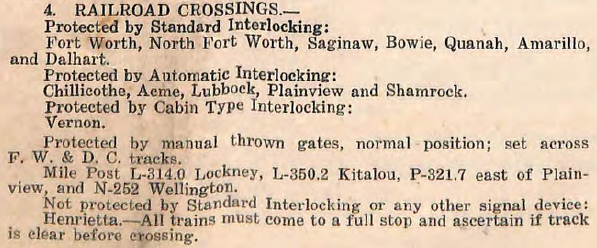 |
Left:
This excerpt from the FW&DC Wichita Falls and
Amarillo Divisions Employee Time Table No. 5 dated June 20,
1937 lists the locations where the FW&DC crossed other railroads.
Plainview and Lubbock are shown with Automatic Interlockings. Crossings
that are "Protected by manual thrown gates, normal position;
set across F. W. & D. C. tracks" include Lockney
and "east of Plainview" at milepost P-321.7, two miles
from Tower 142 (noted elsewhere as P-323.7.) Note that
Henrietta was neither interlocked nor gated
at this time, and thus, "All trains must come to a full stop..." Since
this warning is not included for gated crossings, the implication is
that trains could approach at restricted speed and continue across the
diamond if the gate was open.
Below: The 1937 timetable's subdivisions show that Silverton was
paired with Dimmitt while Lubbock was pared with Estelline ("Plains
Junction"). This was undoubtedly done to ensure that Fort Worth -
Lubbock passenger trains were managed by a single subdivision west of
Plains Junction.

 |
In the early 1930s, the QA&P began marketing
itself as a provider of transcontinental "bridge" service via Floydada, with the
Frisco handling trains north of Quanah and Santa Fe handling trains west of
Floydada. Santa Fe bitterly resisted the QA&P's "Floydada gateway", preferring
to interchange with the Frisco at Avard, Oklahoma. In 1933, Santa Fe officially
announced their intent to "close" the Floydada gateway. This led to battles
waged by the QA&P and Santa Fe in front of regional and national management of
the Interstate Commerce Commission (ICC).
Although the QA&P lost every time, Santa Fe did not promptly execute their plan
to "close" the Floydada gateway. This gave the QA&P time to file for rehearing
at each level while maintaining the status quo at Floydada. The QA&P eventually
reframed their argument into a rate discrimination case. Yet another ICC
hearing was held, this time in Oklahoma City in October, 1936. The ICC forced
Santa Fe to disclose its rate agreements elsewhere, and the released information
bolstered the QA&P's arguments. This time, the ICC examiner found in favor of
the QA&P, and the ICC commissioners did so as well in February, 1938.
By
1939, the Floydada gateway was wide open to transcontinental traffic. After
collaborating on both local and transcontinental interchange at Floydada for two
decades, Santa Fe and the Frisco agreed in 1959 to initiate twice daily
transcontinental "hot shot" trains in each direction between St. Louis and the
west coast. Locomotives and cabooses (and nothing else) were switched out at
Floydada. To expedite "hot shot" trains, Towers 212 and 213 were commissioned at
Lockney and on the east edge of Plainview to automate the two P&SF / FW&D crossings on
the Floydada District.
Right:
This P&SF Slaton Division timetable dated April 26, 1964 lists the two
automatic interlockings that were added to the Floydada
District at
Lockney and at "Plainview (M.P. 2.2 Floydada District)", i.e. on the
Floydada District 2.2 miles east of the Plainview Yard. |
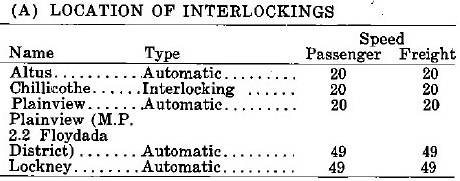 |
Per the above table, the two interlockers on the
Floydada District had the highest speed
limits, 49 mph compared to 20 mph elsewhere. Both were on straight (or nearly
so) track segments which undoubtedly helped. It also seems likely that as the
two newest interlockers, they were specifically designed for high speed use in
support of the "hot shot"
trains on the Floydada District.
 |
Left:
The January, 1962 issue of Railway Signaling and
Communications lists Santa Fe as having installed interlockers at both
Lockney and Plainview during 1961. They are identified as type "AA", a
code for "Addition, Automatic" -- that is, completely new automatic interlockers,
not conversions of existing interlockers. Both are shown with "4h
4d", i.e. a home and distant signal in each of the four directions. |
Santa Fe and QA&P / Frisco traffic exchanges including
the "hot
shot" trains continued at Floydada until the early 1970s. At that time, Santa Fe
officials approached Frisco management to discuss closing the Floydada
connection and moving all exchange traffic to Avard, Oklahoma. A deal was struck in early
1973, and in August, the hot shots began running via Avard. The loss of daily transcontinental traffic through Floydada was almost
immediately replaced by a deal between the FW&D, the QA&P and Santa Fe to run a
daily FW&D train between Acme (on the FW&D main
line near Quanah) and Lockney. A
major derail on the FW&D tracks between Estelline and Sterley had wiped out one
of the two tunnels on that branch, necessitating extensive and lengthy repairs.
The temporary arrangement detoured FW&D trains between Acme and Floydada (QA&P
tracks) and between Floydada
and Lockney (Santa Fe tracks) to bypass the collapsed tunnel.
Because the only connecting track at Lockney was
in the northwest quadrant, westbound FW&D detours coming into Lockney from
Floydada needed to go far enough west to be able to back up onto the connecting
track to reach the FW&D tracks and then resume the trip south to
Lubbock. The opposite move was required for trains originating at Lubbock.
The FW&D began talks with the Frisco about acquiring the
QA&P between Acme and Floydada rather than rebuild the tunnel. The talks progressed to the point that a
deal was within reach. The FW&D needed Santa Fe to grant trackage rights on the
twelve miles of track between Floydada and Lockney that the FW&D had been using
for detours. This track was now lightly used since Santa Fe and the Frisco had
moved all of their interchange traffic to Avard. Everyone agreed to the deal,
including local Santa Fe management. Santa Fe senior management, however, chose
to kill the deal, not admitting, but apparently still harboring, animosity a
half-century later for the FW&D's invasion of the South Plains! The FW&D was
forced to repair the tunnel by "daylighting" what was left of it to be
able to resume operations on the branch at Estelline. The last detour train via
Floydada and Lockney
was in January, 1975.
In 1978, the FW&D abandoned the twenty miles of
track from Sterley north to Silverton. Operations continued from Estelline
through Sterley to Dimmitt and from Sterley south to Lubbock. At the end of
1982, the FW&D was merged into its parent company, Burlington Northern (BN),
successor to the Colorado & Southern which had owned the FW&D for decades. In
1991, the FW&D line between Estelline and the east side of Plainview was
abandoned by BN, and the following year, BN abandoned the Sterley - Lubbock
tracks. This left BN with the Plainview - Dimmitt tracks as its only presence in
the South Plains. BN's successor, Burlington Northern Santa Fe (BNSF), continued
to operate between Plainview and Dimmitt until 2007 when the line was sold to
the West Texas & Lubbock Railroad, owned by transportation company Iowa Pacific.
Along with the two branches out of Lubbock, the Dimmitt line was acquired by the
Lubbock and Western Railroad (LBWR) in 2015. In the late 1980s, Santa Fe began to ponder selling the
entire Floydada District despite having been unwilling to grant a dozen miles of trackage
rights on it. In 1990, Santa Fe sold the Plainview
- Floydada line to short-line operator Amerail. Six years later, Santa Fe merged
with BN to form BNSF, successor to both Santa Fe and the FW&D.
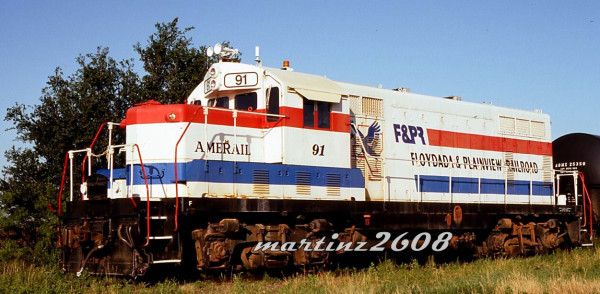 |
Left:
In March, 1990, Santa Fe sold the Floydada branch line to Amerail which
organized the Floydada and Plainvew Railroad (FPRR.) Unable to improve
business prospects after three years, the FPRR abandoned twenty-two
miles of the line between Floydada and the outskirts of Plainview. (image, EBay, martinz2608) |
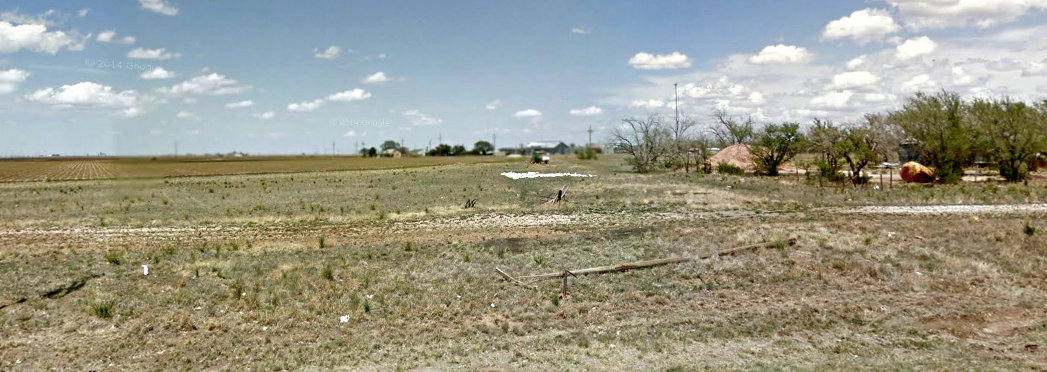
Above: Both lines are
abandoned, but vague traces of the crossing at Lockney remain visible in this
north-facing Google Street View from 2013. The Santa Fe right-of-way runs
horizontally right-to-left (toward Plainview) beginning on the white ballast at
the middle of the right edge of the image. It immediately crosses the FW&D
grade at a right angle, about where the ballast initially diminishes. The FW&D
grade exits the image in the bottom right corner toward Lubbock. More prominent
is the outline of the connecting track in the northwest quadrant of the junction.
Its years of existence caused it to become a boundary for the cultivation of the
cotton field visible beyond it.
Right: ((c)historicaerials.com, 1957) Sterley
was critical to the FW&D's
operations on the South Plains. Connectors for Lubbock (southeast
quadrant) and
Silverton (northeast quadrant) are apparent.
Below: Only faint
traces of the former FW&D tracks through Sterley are evident in this
Google Earth image from 2016.
 |
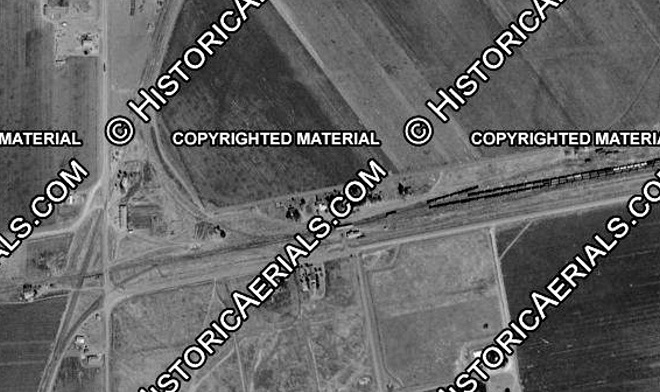 |
Ben Sargent describes the FW&D's operations between
Estelline and Sterley in the 1920s...
After the westbound “main-line” train left Estelline for Denver, a branch-line
train left Estelline and went to Sterley. At that point, mixed trains set out on
the Dimmitt and Silverton branches, and the branch-line train continued to
Lubbock. (And of course, the whole arrangement then ran in reverse back to
Estelline to catch the Fort Worth train.) Sterley must have been a yard facility
of some substance, but there’s no trace of a railroad there now…..
Right:
Manufacturer's Record, September 21, 1916
In 1916, the
Lubbock & Great Northern Railroad announced plans to build between
Lubbock and Hollis, Oklahoma, passing through Lockney. As it was for
many such railroads, the line was never built.
Below:
Scudder Manual of Extinct or Obsolete
Companies, Vol. 1, 1926, page 709
 |
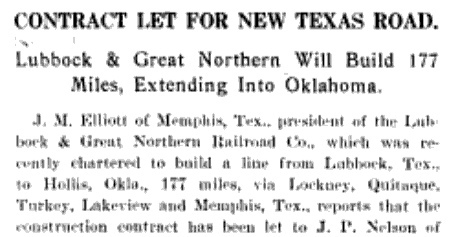 |
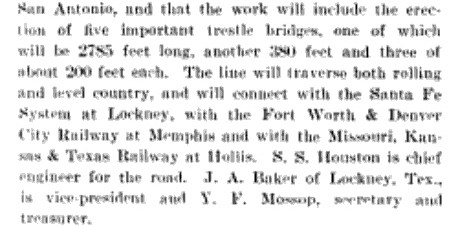 |
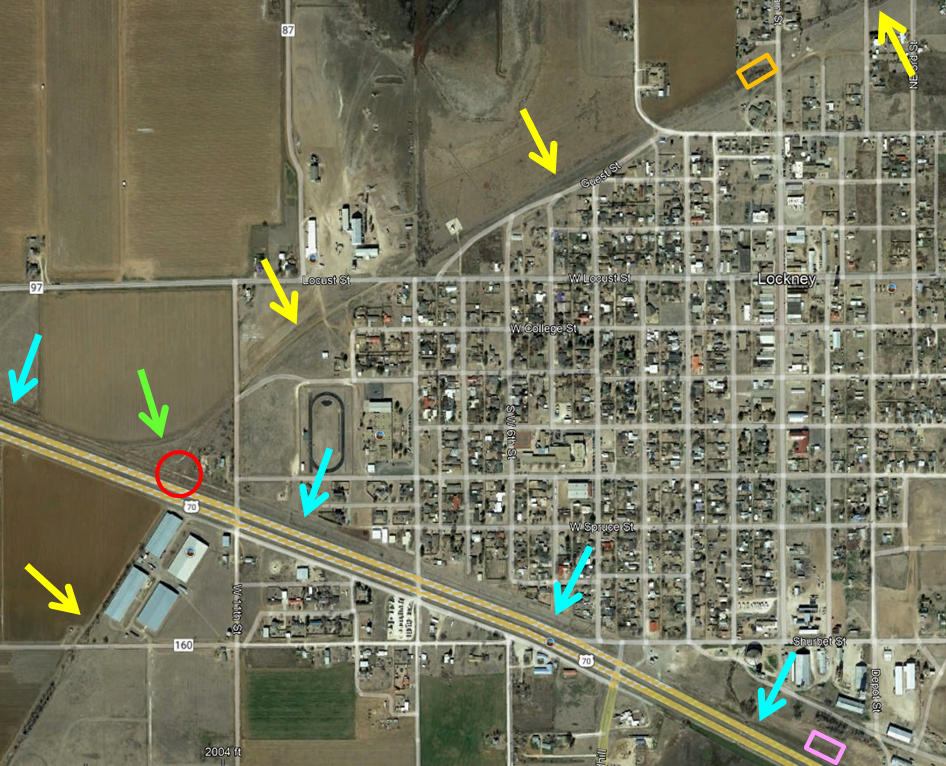 |
Left and Below: These Google Earth images
(2016) of Lockney have been annotated to show rail locations. The Santa Fe
right-of-way (blue arrows) went from Plainview (left) to Floydada (right) at an angle across the south part of town. The FW&D
right-of-way (yellow arrows) crossed on a northeast / southwest heading (Sterley, north, Lubbock, south), and made a slight bend as it passed through
Lockney. The Tower 212 interlocker controlled the crossing (red circle.) The
only connecting track was in the northwest quadrant (green arrow.) It's apparent from the image and
from Depot St. being nearby that the Santa Fe depot (pink rectangle) was
trackside near
the main highway (now U.S. 70.) What's less apparent is that there was also a
FW&D depot (orange rectangle) along Main St. on the north side of town, with its
foundation still clearly visible (below.) Both depots
were a mile from the Tower 212 crossing.
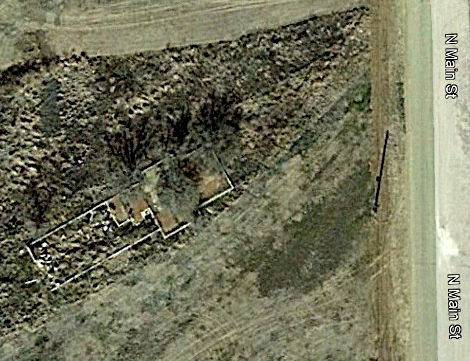 |

Above: This Google Earth satellite image from July, 2023
is centered on the Tower 213 crossing (red circle) "east of Plainview". The
crossing is two miles east of Tower 142 where the FW&D (yellow arrows) crossed
the Santa Fe main line to Lubbock. Santa Fe's Floydada
District (blue arrows)
connected into the main line at Santa Fe's yard near Tower 142. A spur (yellow
dashes) still exists that switches off of Santa Fe's tracks and becomes a siding
for the FW&D, continuing for about 0.6 miles before connecting. The spur serves
a cotton warehouse complex and appears on 1957 historic aerial imagery.
Below: This June, 2023 Google
Street View image looks north from U. S. 70 near the "east of Plainview" crossing. The
abandoned Tower 213 cabin is at far left. The diamond is not directly visible,
but the foreground tracks change identity on either side. The red switch stand
barely visible to the right of the dirt road switches the siding that parallels
the former FW&D track through the warehouses visible at far right (partly
obscured by the trees.) The warehouses are owned by Farmers Cooperative Compress
serving the cotton industry. Historic aerial imagery shows that the siding has
been in place since at least 1957 when it served a complex of nine warehouses.
Today, there are 45 warehouses!

Below: The two rail lines
going east out of Plainview were nearly parallel as they approached the Tower
213 crossing (lower right corner of the image) two miles east of Tower 142. The
north track is the former P&SF to Lockney and Floydada; the south track is the
former FW&D to Sterley and Estelline. Both tracks now serve customers and
terminate on the outskirts of Plainview. The proximity to both rail lines made
the area between them ideal for use as a yard for windmill parts. The gray items
are horizontal stacks of windmill blades used for power generation. An exchange
track at the west end of the yard connects to both lines, crossing County Rd. Y
in between. Presumably the yard switching is handled by LBWR. (Google Earth,
2021)

















